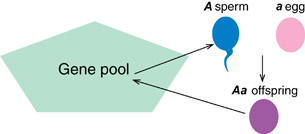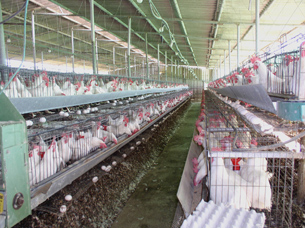Module 8
1. Module 8
1.5. Page 3
Module 8—Populations, Individuals, and Gene Pools
 Module 8: Lesson 1 Assignment
Module 8: Lesson 1 Assignment
Retrieve the copy of the Module 8: Lesson 1 Assignment that you saved to your computer earlier in this lesson. Complete Part A. Save the completed assignment in your course folder. You will receive instructions later in this lesson about when to complete Part B and when to submit your assignment to your teacher.
Hardy-Weinberg Equilibrium (HWE)
In the Amish population, the recessive allele for polydactyly is much more common than in other North American populations. One wonders whether the allele for polydactyly will increase in North American populations and why. Do the frequencies of alleles stay the same generation after generation in a population, or can they change?

Consider any population that has two different alleles for one gene—for example, A and a. It would seem logical that if each breeding couple in a population removes two alleles from the gene pool in order to reproduce and then returns them to the gene pool in the form of offspring, the relative frequencies of each allele in a gene pool should not change from generation to generation. In other words, the population should stay in equilibrium.

© A74.FR Ben Fontaine/3339382/Fotolia
Godfrey Hardy and Wilhelm Weinberg are famous for making just that observation: allele frequencies should stay the same generation after generation—a situation they called Hardy-Weinberg equilibrium. Hardy and Weinberg realized that this can only hold true if certain conditions exist.
Conditions Necessary to Maintain Hardy-Weinberg Equilibrium
- The population must be closed. In other words, there can be no immigration of individuals (and alleles) into the population or emigration of individuals (and alleles) out of the population. In other words, there must be no gene flow. Natural and artificial barriers (mountain ranges, highways, canyons, large bodies of water, urbanization, clear-cutting) prevent organisms from mixing and adding to or removing their genes from a population’s gene pool.
- The population must be large enough that chance events will not alter the frequencies. (Missing one penny out of five is a much bigger event statistically than missing one penny out of a thousand.)
- There must be random mating (no picking favourite phenotypes or genotypes as mates). Although most complex animals go through some sort of mating ritual that allows them to select a certain kind of mate, simple organisms like bacteria, fungi, or wind- and water-pollinated plants are examples of those where mates are not selected.
- There can be no net mutations. There are always mutations, but the mutation rate from B to b must be equal to the mutation rate from b to B in order to stay in HWE.
- There can be no natural selection. The environment cannot favour the survival of one phenotype over the other.
So, which populations are in Hardy-Weinberg equilibrium? If you look carefully at the list of conditions for HWE above, you can see it would be difficult, if not impossible, to think of a natural population that meets all these conditions. The photo of the chicken barn above depicts a population in HWE.
If HWE is just a hypothetical situation, why are we interested in these five conditions that lead to HWE? We use HWE as a test to see if populations are undergoing change. If any of the five conditions listed do not exist, then the population is undergoing genetic change, or microevolution, and the relative frequencies of the alleles must be changing. Microevolution, or a change in allele frequencies, can’t result in new species all by itself, but it can change the genetic characteristics of a population substantially as one allele becomes increasingly common.
Hardy-Weinberg Equilibrium: a principle that states that allele frequencies in a population will remain the same over time as long as the population is large, there is no gene flow, natural selection is not occurring, there is no change in mutation rate, and no mate selection is occuring
If allele frequencies do change, it indicates that microevolution is occurring in the population.
gene flow: movement of alleles into or out of a population by immigration or emigration
natural selection: the process by which organisms with heritable traits survive in a particular environment, passing on their successful traits to the next generation
Those selected have greater reproductive fitness that either increases fertility or decreases mortality.
microevolution: a change in the frequency of alleles in the gene pool that results in a change in the characteristics of the population; does not result in a new species
 Read
Read
To review these concepts, read “Introducing the Hardy-Weinberg Principle” on pages 680 to 682 of your textbook. You may wish to make summary notes or include some example problems and their solutions in your course folder.
 Watch and Listen
Watch and Listen
To review and summarize the information of this lesson, watch “The Hardy-Weinberg Principle: Minding Your p's and q's.” Although you may wish to watch the entire video for interesting examples, pay particular attention to the following sections:
- “Population and Gene Pools”
- “Population Genetics”
- “Bio Review: Calculations”
- “Bio Simulation: Allele Frequency”
 Try This
Try This
TR 1. Identify two kinds of populations that would exhibit the five conditions of HWE.
TR 2. Look at question 4 on page 700 of the textbook. Note that 11% of the Canadian population is lactose intolerant. Would this be the same in other countries? Why?